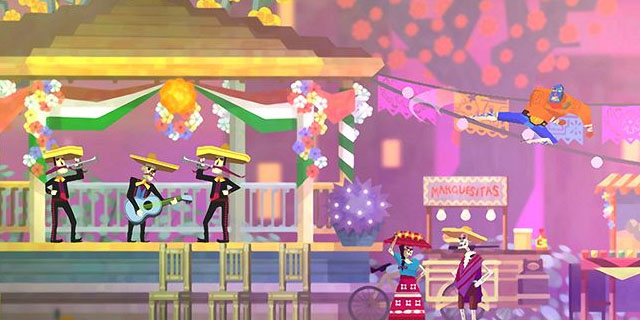
Drinkbox Studios first released Guacamelee! for the PS3 and Vita last year. It made appearances on two of our Staff Picks lists, but due to circumstances beyond our control, it never got an official Snackbar review. Thankfully, an updated Super Turbo Championship Edition was recently released to all the home consoles, giving us a chance to correct this oversight.
This finely-crafted love letter to both Mexican culture and video games in general is, at its core, a Metroidvania-style adventure with a combat emphasis taken from arcade-y beat-’em-ups. As you progress through the game, you will receive new attacks and other moves that will aid you in exploring the various areas in which the story takes place. As a Metroidvania, there will inevitably be backtracking as your new abilities gain you access to areas that were previously closed off, but most of it is narratively justified until you reach the endgame.
The hero of our story is Juan, a humble agave farmer living outside the small Mexican town of Pueblucho as the town prepares for its Dia de los Muertos festival. Disaster strikes on his way to visit El Presidente’s daughter, as gangs of rampaging skeletons attack the town and take her captive. Even worse, Juan himself is actually killed by the leader of these skeletons, Carlos Calaca! Fortunately, while in the land of the dead the spirit of a heroic luchador (wrestler) bestows his mask upon Juan and allows him to return to the land of the living to stop Calaca before he can merge the two worlds into one under his rule.
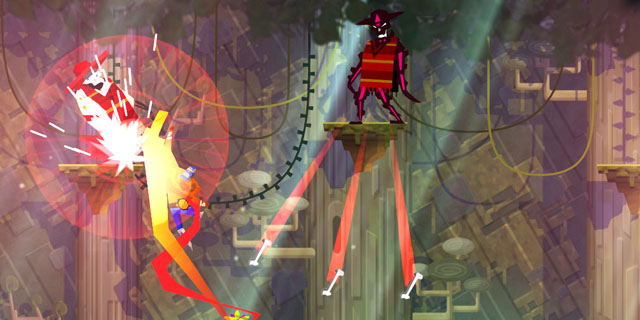
From there the story unfolds in the usual way, with Juan eventually learning the backstory of not only Calaca but his miniboss underlings too — usually right before he beats them into a pulp, of course. Along the way he will learn new moves from a cranky goat-hermit, be turned into a chicken (Guacamelee!‘s answer to the Morph Ball) and even encounter El Diablo himself (kind of) as he fights off hordes of reanimated skeletons as well as the occasional chupacabra and other enemies.
Combat in Guacamelee! is fast-paced and combo-heavy. Juan has a basic punch combo and can launch enemies into the air for additional hits. Once an enemy is weakened, he can grapple it and either throw it into other enemies or execute a wrestling move for big damage to his victim and any other enemies close by. Eventually enemies will develop shields that can only be broken by hitting them with one of Juan’s special attacks, but both the attacks and the shields are color-coded to make this easier. Be aware that these special moves will drain Juan’s stamina meter, which recharges over time but can be emptied if you abuse them too much.
Juan can also dodge with the press of a button (or the right control stick), which is even effective on some environmental hazards like thorns. Different enemies require different tactics, but you’ll be slamming skeletons around with ease once you grasp the basics. Defeating an enemy will earn you cash and a little bit of health, so be sure to wipe them out whenever you can. As a bonus, enemies will not respawn until you leave the area, so once you’ve cleared everything you’re free to explore.
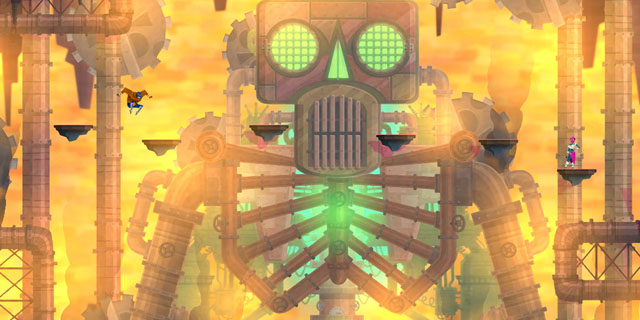
The platforming aspect of Guacamelee! is just as solid, although I had trouble using the left control stick (on my Wii U GamePad) when it came to special move recognition, so I stuck to the always-reliable D-pad; your experience might vary depending on console of choice. While the game revels in its old-school roots with some truly punishing obstacle courses, it does so without a lot of the frustration that is all-too common with others of its ilk. Hitting an instant-death obstacle will usually just force you to respawn on the last solid horizontal surface you touched, although some specific (and thankfully rare) puzzle areas do force you to retry from the beginning.
For the most part, the obstacles are deviously tricky but not impossible, but the ones that really shine are the ones that make use of Guacamelee!‘s dimensional shift mechanic. As he is sort of stuck between the land of the living and the land of the dead, Juan can eventually shift between them at will. Doing so will often change your immediate environment, as some obstacles only exist in one of the two worlds. These obstacles are thankfully indicated by a kind of sparkly finish (and also specially indicated on your map) so you know when you will need to think more outside the box than usual. Dimensional shifting is also needed during combat, as some enemies will only be vulnerable in one of the two worlds and be nothing but shadows in the other. Shadows that can still damage you, mind, so be ready.
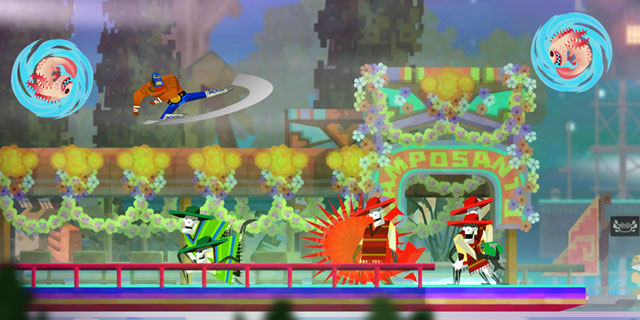
Mechanically, Guacamelee! is as brilliant as the best entries in its genre. The writing is also incredible, finding humor in common Mexican tropes while still honoring the culture. It never feels like it’s making fun of it, or being lazily stereotypical, but rather having fun with it in a satirical way. It’s a fine line, and the writing team walked it commendably. Latinos and their heritage aren’t very well-represented in gaming, and on the whole it felt like a welcome change of pace. The game might look like a stylized cartoon (the art style reminded me most of The Emperor’s New Groove, appropriately), but it was definitely written for a more mature audience.
Of course, it helps that Guacamelee! also deeply mines both lucha libre and game culture itself for additional material. Hardly a scene goes by that doesn’t reference some combination of pro wrestling, classic video games (and some modern games modeled on classics, like VVVVVV and Fez) and even the occasional internet meme in some way. Often these take place as background jokes, like a statue carved in the shape of Donkey Kong, a poster on the wall depicting a suspiciously-familiar tag team of mustachioed brothers in green and red trunks or a mural depicting another skeleton-smashing hero (this one armed with a whip). Other times the reference will be more blatant, like the method by which Juan learns new abilities from the goat-hermit or the “A WINNER IS YOU!” message you receive upon completing the game. (Related note: why has Pro Wrestling never been ported to a Virtual Console?)
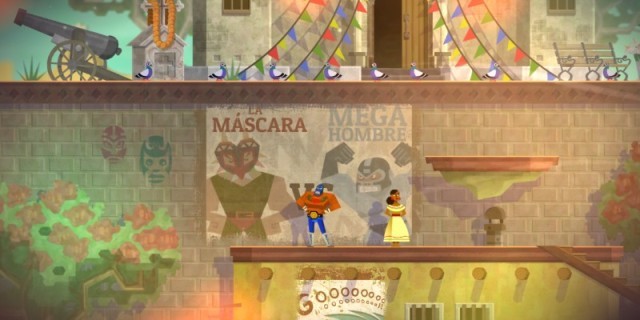
Speaking of finishing the game, that’s where Guacamalee! might lose some players. It’s simple enough to make it to Calaca and defeat him, but if you want the happy ending you’re going to have to work for it. Scattered throughout the game are six “mask orbs” that you must find if you want to do so. These are deviously hidden, and many of them will require you to have mastered your platforming skills to a degree that only the hardest of the hardcore will achieve. (Actually, I was able to see the Happy Ending in the Extras menu after receiving the normal ending, but I didn’t feel like I had earned that right until I got all the mask orbs. I admit to looking up the location of one or two, but still had to do the work required to actually get them!)
Guacamelee! veterans might be asking themselves, “wait, six mask orbs? I thought there were only five!” And in the original game, that was indeed true. But Super Turbo Championship Edition brings with it several additions, mostly seamlessly integrated DLC from the previous version. This includes two new regular areas, a backstory for Player Two’s character Tostada (who is also playable as the main character if you so desire, although I don’t think the story changes), an additional boss battle, some new abilities, costumes that can be purchased via silver pieces (earned from chests and combat room piñatas), additional chests and El Infierno: a series of hellish challenges that will test your skills in 17 different ways. One of these additions holds the additional mask orb (hint: it’s that last one), so good luck with that.
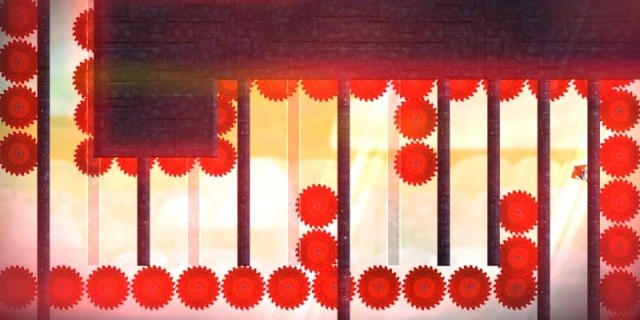
While I did not 100-percent clear my run on normal mode or try the two-player cooperative mode, Guacamelee! still occupied a good 15 hours of my time, and only the last five or so of that was searching high and low for things I had missed. I don’t know if I could have beaten Calaca without getting some of those last health and stamina upgrades, but who knows. Full completion would probably take another five depending on how good you are at the challenges in El Infierno, and then there’s always hard mode if that’s your thing.
My only real complaint is how few upgrades there are to purchase. By the time I finished I had picked up all of them and had about $10,000 or more still in my possession just from naturally fighting things. I don’t know what else could have been added, but a way to convert cash into silver might have been nice, since that commodity is kind of rare and only useful for the costumes. Or maybe a map that shows me where all of the hidden chests are, so I don’t have to traipse all over blindly searching for whatever nook or cranny I missed?
Still, those are the most minor of minor gripes. Guacamelee! Super Turbo Championship Edition is among the elite of indie offerings this year, and anyone who missed out on the previous version and enjoys a well-written and challenging adventure would be doing themselves a disservice to ignore it this time. I’m sure even a few veterans would be more than willing to drop an additional $15 on this expanded edition, just to experience this excellence again.
Pros: Fast-paced combat with Metroidvania platforming, well-written depiction of an under-represented culture
Cons: Brutal platforming challenges, not enough use for in-game cash



















